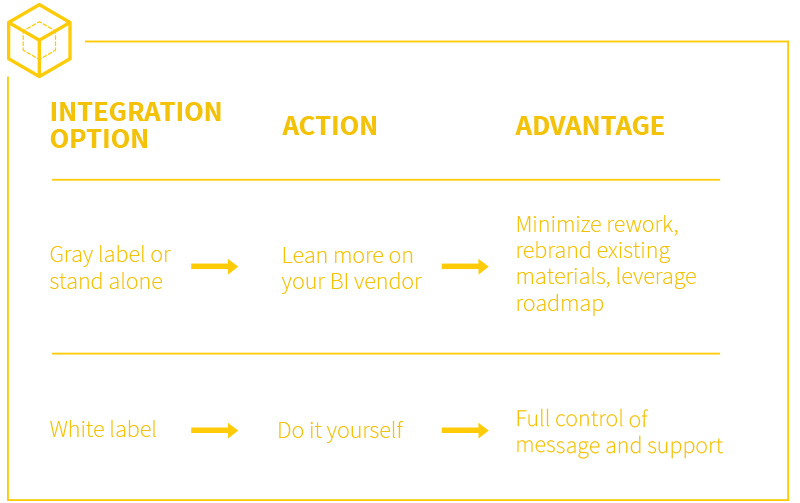
The 5 most common mistakes when embedding analytics
There are five common mistakes that lead to failed analytics products. Give your application the best chance for success by avoiding these five mistakes
I’ve spent the past 20 years working in analytics. Over that time, the industry has come a long way, in both impact and awareness. Whilst for many years my family and friends described my job as “IT”, today they know and understand what I do for a living (although I do still get calls to fix their internet).
From every perspective, the analytics industry has come so far lately, as more organizations are surfacing the value in their data. At Yellowfin I’ve been fortunate to work with some phenomenal partners around the world, helping them embed analytics into their products. While there’s been many great successes along the way, I’ve also seen plenty of mistakes (and made quite a few myself).
Embedding analytics isn’t plug-and-play. It’s all too easy to make mistakes that can be the difference between a successful launch and one that just doesn’t deliver value to your customers. Here are the five most common mistakes that I see regularly:
1. Not having a clear commercial goal
One of the most common things that businesses overlook before embedding an analytics solution is clearly defining their commercial vision and goals.
Based on what we see, most businesses are looking for either competitive parity or competitive advantage (as shown in the illustration above). Parity is the most common starting point for a business. There is less risk in parity because you already know that your target market values these capabilities.
Competitive advantage is about striving ahead and being innovative. Perhaps you’ve identified a gap in the market and believe you can add value to your customers by doing something new.
With a clear commercial objective in mind, your business can then dictate the amount of resources, time and effort that it makes sense to allocate to the project. The objective will also dictate your go-to-market strategy and help price the analytics application. For example, that competitive advantage you create could justify a premium price point for the analytics component of your product (but do get customer feedback on that first). This reflects the customer value proposition, as well as the time, effort and money that your business has invested.
Whether your objectives are to keep up with the pack or strive ahead, it’s important to be clear about where you’re going upfront. Your commercial objectives must guide your strategy, not the other way around.
2. Not bringing in the right team
The second mistake that I see often is when businesses don’t realize their own skill gaps. Practically, this means that they ask their existing internal team to deliver an embedded analytics solution without regard to their skills in the area (or lack thereof).
There are a range of team capabilities that you need to take a successful embedded application to market. One of the things that is often missing from the outset is core BI skills. This is particularly important in the brainstorming and initial data analysis phase.
To build an application with engaging content that your customers will value, you must first understand how your information is structured. Great data analysis skills make sure your product deliver those nuggets of gold that get your prospects saying “I want that one”.
These skills help transform this understanding into requirements for your technical team in developing the product. They inform how to structure information in a way that that brings value to your customers and enables them to interpret information. A good data analyst knows what answers your customers are looking for and can help build a dashboard that is engaging – they know that a line chart will show your customers what has changed over time and that the most critical KPIs should be positioned in the top left corner of the dashboard so they’re seen.
You only get one chance to make a good first impression with your shiny new embedded analytics solution, so you want to make sure that it’s going to pop. It has to hit the right notes with your audience and resonate with them – for all these reasons it’s critical to get the right people with the right skills onboard from the start. Trying to shoehorn your existing team will use up a lot more time and resources and typically results in a product that doesn’t hit the mark.
3. Failing to emphasize good design
Another mistake that many businesses make is to underemphasize the importance of great design in winning over customers.
Countless times I have seen dashboards that have 15 reports and 30 filters – they’re trying to cram every important metric in every way possible. Throwing in everything and the kitchen sink is not a coherent design approach. Having every bell and whistle can be overwhelming and intimidating for customers (and they just won’t use it).
You must design the application for your target personas. To do this, first build out your personas and detail their needs. Who are they? What do they want to achieve and how will the analytics help them do this? How will they use the analytics? How often will they use it for? How tech savvy are they?
Another common design mistake is being too heavily influenced by the way people have historically interacted with your data. Tabular spreadsheet-esque content is a great example. Just because people are used to seeing data this way doesn’t mean it’s the best way to convey the information. Visualizations generally help people absorb information better, faster, and easier. Look at the tools you have and make the most of their capabilities for your customers.
4. Not thinking about the right level of integration
There are different ways that you can embed analytics into your application, but many people don’t take the time to really think about the right level of integration at the outset. Simple things like single sign-ons make the application much easier and seamless to use. The right integration delivers a better customer experience and makes it easier for your sales team to sell the product.
White labelling means you can completely customize the embedded the analytical application into your own platform. Customers need only one sign-on and it has the same look and feel – it’s a small task but it makes a big difference in the mind of the customer because they believe they’re buying one product. This also means that there’s no confusion in the marketplace, customers know they’re buying your product. White labelling gives you the most control and limits the confusion to the customer, but it means you can’t lean on the underlying vendor for any collateral or direct your customers to their support materials
Grey labelling is the next level down. It’s essentially white labelling but it shows who is powering your embedded solution. For example, it might say “Powered by Yellowfin”. Grey labelling is generally our recommended solution. Why? Because grey labelling gives you the best of both worlds. You have the advantages of white labelling and can lean on the vendor for collateral materials, roadmap and training. This means you can test the waters and get your customers excited about the features that are coming down the road.
The third option is to not integrate at all. The analytics application sits next to the product and has the BI vendor’s look and feel, it just uses your product’s data. While this might be the easier path, you end up causing confusion to your customer base and it can complicate your sales process.
5. Failing to understand what the customer really wants
The final mistake that I’ll mention is that businesses often make assumptions about what their customer wants without talking to them. To get your product right you need to understand exactly what is going to excite your customers and sell you more product. Too often I’ve seen organizations create dashboards and dozens of reports, but only a small % actually get used.
Many businesses think they know what their customers want in their analytics and dashboards, but it is always important to talk to your customers and find out what they really need before taking the product to market. If you don’t have any customers, try to talk to other people in the marketplace and understand what will resonate. Then take that feedback into the design of your application. It will provide you with a better analytics solution in the long run.
If you don’t speak to your customers, you’re going in blind. You don’t want to spend a lot of time and wasted energy in producing something that quite simply isn’t used.
Embedding analytics in your application can provide tremendous value to your product and customers. By keeping these tips in mind you can help ensure that you build a successful product that drives value for your customers and revenue for your business.



